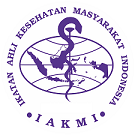Risk Factors of Maternal Death in Karanganyar, Central Java, Indonesia
Abstract
Background: The maternal mortality rate is an indicator of national health status. To reduce the Maternal Mortality Rate (MMR), especially in Karanganyar Regency, the risk factors that affect maternal mortality must be known.
Subjects and Method:
References
Aeni N (2013). Faktor risiko kematian ibu (Risk factors for maternal death). Jurnal Kesehatan Masyarakat Nasional. 7(10):453-59.
Alkema L, Doris C, Daniel H, Sanqian Z, Ann-Beth M, Alison G, Doris MF, Ties B, Marleen T, Colin M, Lale S (2016). Global, regional, and national levels and trends in maternal mortality between 1990 and 2015, with scenario-based projections to 2030:
a systematic analysis by the UN Maternal Mortality Estimation Inter-Agency Group. The Lancet. 387 (10017): 462-474.
Astuti SK, Aziz MA, Arya IFD (2017). Maternal mortality risk factors in Dr. Hasan Sadikin General Hospital, Bandung in 2009?2013. International Journal of Integrated Health Sciences. 5(2): 52-56.
Devi KP, Singh LR, Sing B, Singh MR, Sing NN (2015). Postpartum Hemorrhage and Maternal Deaths in North East India. Open Journal of Obstetrics and Gynecology. 5: 635-638.
Central Java Provincial Health Office (2015). Profil Kesehatan Provinsi Jawa Tengah Tahun 2014 (2014 Central Java Health Profile). Semarang.
Central Java Provincial Health Office (2016). Profil Kesehatan Provinsi Jawa Tengah Tahun 2015 (Health Profile of Central Java Province in 2015). Semarang.
Ghulmiyyah L, Sibai B (2012). Maternal mortality from preeclampsia/eclampsia, Seminars in Perinatology; 36(1): 56-59.
Haeri S, Dildy GA (2012). Maternal Mortality from Hemorrhage. Seminar Perinatology; 36: 48-55.
Halder A, Vijayselvi R, Jose R (2015). Changing perspectives of infectious causes of maternal mortality. Journal Turkish-German of Gynecological Association. 16(4):208-213.
Ministry of Health of the Republic of Indonesia (2015). Profil Kesehatan Indonesia Tahun 2014 (Indonesia Health Profile 2014). Jakarta: Kementerian Kesehatan RI.
Ministry of Health of the Republic of Indonesia (2013). Riset Kesehatan Dasar (Basic Health Research). Jakarta: Badan Penelitian dan pengembangan Kesehatan Kementrian Kesehatan RI.
Kumar N (2016). Postpartum Hemorrhage: A major killer of woman: Review of current scenario. Obstetrics Gynecology International Journal; 4(4): 1-7.
Kumar A, Agrawal N (2016). Brought in dead: An avoidable delay in maternal death. Jurnal Obstetrics Gynecology India; 66(1): 6-60.
Muthoharoh NA, Purnomo I, Nurlatif V (2016). Faktor
Shennan AH, Green M, Chappell LC (2017). Maternal deaths in the UK: preeclampsia deaths are avoidable. The Lancet. 389(10069): 582
WHO (2016). Maternal mortality, fact sheet. Retrieved from http://www.who.int/mediacentre/factsheets/fs348/en/.
WHO (2014). Trends in Maternal Mortality: 1990 to 2013. Retrieved from http://apps.who.int/iris/bitstream/10665/112682/2/9789241507226_eng.pdf
WHO (2011). Unsafe abortion: Global and regional estimates of the incidence of unsafe abortion and associated mortality in 2008. Sixth Edition. WHO.











